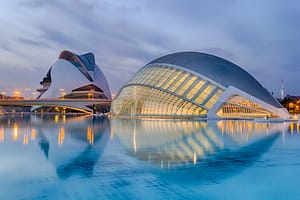Where you go at night in Valencia depends on when you visit. The best area in the cooler months is historic Barrio Carmen, in the city center. Valencia is famous for its marcha (nightlife) and for its bohemian bars. Calle Alta is a good street on which to start your bar-crawl, as is the historic core around Plaza del Ayuntamiento.
A longtime local favorite is Cafeteria Barcas 7, at the same address as the name, among banks and office buildings in the heart of town directly north of Estación del Norte. It serves drinks and tapas (including small servings of paella) at the stand-up bar. You could stop here for your first cup of coffee at 7am and for your final nightcap at 1am. There is often live music in the evening. It’s open daily from 7am to 1am. Drink prices start at 1.50€, and tapas cost 4€.
In the Barrio Carmen, Disco City, Calle Pintor Zariñena 16, is a dance club with black-on-black decor and a wall of mirrors lining the dance floor. It attracts the under-30 crowd, who come here to dance to funk, soul, and R&B. It’s definitely for late-nighters: The scene doesn’t get rolling until 3am. Cover is usually 15€.
In summer, the emphasis switches to the beach, Playa Malvarrosa. Everyone from teens to 40-somethings congregates around open-air bars, which play music, often have dance floors, and are open from late May to September. Drinks usually cost 4€ to 6€. There are also discos in this part of town, one of which is the salsa room at Akuarela Playa, Calle Eugenia Viñes 152. Cover is 12€ to 17€, and drinks are several euros more than in the open-air bars.
Valencia is Spain’s third-largest city and, after Madrid and Barcelona, the country’s biggest gay center. Most of the action is in the historic center in the Barrio Carmen, particularly along Calle Quart. Valencia is a progressive, liberal city, and visitors need have no fear about being “out” on the street. The best publication for what’s happening, and when, is Madrid-based Shangay, distributed free in gay establishments and available online at www.shangay.com.
The Palau de la Música, Paseo de la Alameda, presents an impressive array of 200-plus programs a year. The most prestigious orchestras in the world, as well as directors and soloists, appear here. Between September and October, the Valencia Orchestra is in residence. The hall seats 1,793 and has wonderful acoustics. After a concert here, Plácido Domingo claimed that “Palau is a Stradivarius.” An on-site art gallery is open daily from 10:30am to 1:30pm and 5:30 to 9pm. Ticket prices vary, but are generally in the 10€-to-90€ range.
Palau de les Arts Reina Sofía, is the grand opera house of Valencia. It’s housed in a futuristic, helmet-shaped building that is part of the City of Arts and Sciences. Some of the world’s most prestigious opera companies perform here. Tickets, costing from 20€ to 175€, are sold at the box office Monday to Friday noon to 8pm.
Neighboring Catalunya may have outlawed bullfights, but corridas still figure prominently in Valencian life. The first fight season of the year is during Las Fallas in March. Fights resume from Easter through May, and start up again in early October. Valencia’s Plaza de Toros is one of the largest rings in Spain; it’s adjacent to the rail station at Calle de Xàtiva. Tours of the ring and adjacent museum are offered all year Monday to Saturday for 10€ for adults, 8€ ages 7 to 16.

